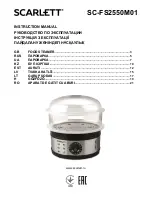
two ways of doing this:
Rapid cooling:
-Use cold water to rinse the pressure cooker
slowly until the control valve drops. The lid
can now be opened as described previously
(Fig.5). The pressure cooker can be cooled
rapidly to prevent the food from overcooking
or if you want to open the lid during cooking.
Place the pressure cooker on a stable surface
under cold running water. Be careful not to wet
the valves directly. The water flow should not
be too strong.
Slow cooling:
-Switch off the hob. Leave the pressure cooker
to depressurise and reach room temperature
if you wish the food to continue cooking. Wait
until the control valve drops before opening the
pressure cooker.
Opening the lid (FIG 4)
-Wait until the pressure is fully released. Never
open the lid without depressurising first.
-Once depressurised, turn the knob anticlockwi-
se and slide the lid sideways
-Allow it to cool.
-Clean the appliance
CAUTION:
-When cooking paste-like dishes or thick broths,
especially vegetable soups, shake the pot
before opening the lid to prevent the food from
splashing.
-Do not tamper with the safety systems, apart
from the maintenance instructions stated in this
user manual. Use only original replacement
parts suitable for the model in question. It is
especially crucial that the lid and the body are
made by the same manufacturer and that they
are compatible. Contact your retail outlet or
customer services for original spare parts.
CLEANING
-Allow it to cool before starting any cleaning
operation.
-After each use, clean the pressure cooker with
a damp cloth with a few drops of washing-up
liquid.
-Rinse the pot under clean water and dry it
using a clean cloth.
-Do not use abrasive dishwasher detergents or
metal scourers as this will damage the pot’s
polished surface.
-Do not use solvents or products with an acid or
base pH such as bleach, or abrasive products.
-To prevent electrochemical corrosion, do not
allow the pressure cooker to come into contact
with other metals.
-It is best to store the pressure cooker with the
lid open. By exposing the silicone seal ring to
air it dries properly.
-If food becomes stuck to the surface, it is advi-
sable to leave the pressure cooker to soak for a
while and then remove the traces with a cloth.
-It is not advisable to put it in the dishwasher,
especially the lid.
CLEANING THE SILICONE SEAL RING
-Remove the silicone seal and clean with hot
water.
-Use a cloth to dry the silicone ring, and keep it
dry. Carefully fit it back into place.
CLEANING THE PRESSURE CONTROL
VALVE, AIR OUTLET PIPE AND SAFETY
VALVE:
-The pressure control valve, air outlet pipe and
safety valve must be kept clean to ensure that
the pressure cooker operates normally (Fig.6)
-Lift the pressure control valve. Check for and
remove any build up of dirt and, if necessary,
use a needle to remove any dirt from the air
outlet pipe.
-Recommendation: To prevent incorrect operati-
on, do not disassemble the safety valve.
REMOVING BURNT FOOD
-Use a wooden scraper to remove any burnt
food. Really baked-on food should be dried
in the sun and then soaked in oil. Next, fill the
pot with hot water and allow it to stand a while.
Then clean the inside of the pressure cooker.
To avoid scratching the body, do not use sharp
utensils, such as blades, to remove heavily
baked-on food.
ATTENTION
-The pot, lid and seal should be cleaned after
each use. Use a needle to remove any dirt from
the pressure control valve, air outlet pipe and
safety valve and store the pressure cooker in
a cool, well-ventilated place. The lid should
be stored upside down on top of the body or
separately.
CAUTION:
-To make the lid easier to open and close, lubri-
(Original instructions)
Summary of Contents for Best Moments KCP4104
Page 2: ......
Page 3: ......
Page 29: ...CE 32 79 UE 86 4102...
Page 30: ......
Page 31: ...FIG 4 6 giF...
Page 32: ...NIM XAM 06 X 52 0 3 2 3 1 4giF 5 giF...
Page 33: ...021 FIG2 3 2 3 1 06...
Page 34: ...A B C E F G H I J K L 1 giF NIM XAM KCP4104 KCP4106 KCP4108 KCP4110...
Page 39: ......
Page 40: ...Avda Barcelona s n 25790 Oliana Spain 19 11 2021...












































